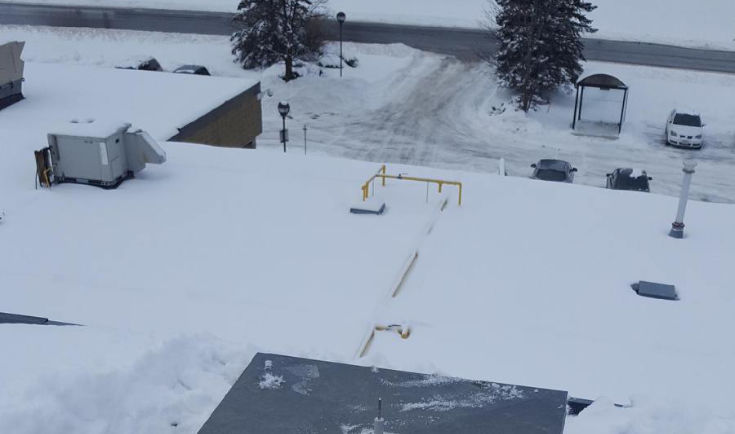
Commercial Roofing Uncovered: Did your Roof Survive Winter?
Commercial Roofing Uncovered: Did your Roof Survive Winter? https://pbroofingco.com/wp-content/uploads/2024/02/5feb8adbb9e689d63aa49a15_snow-covered-roof.jpeg 735 434 PB Roofing https://secure.gravatar.com/avatar/ee28a6949ea6af745b0ddec55b8b9ce1?s=96&d=mm&r=gWinter weather can devastate your commercial roof. Keeping a commercial roof in good repair is vital to preserving its durability and efficiency. Explore the common types of winter roof damage and understand how they affect your commercial property investment below.
Proactive Measures
As the seasons change and the weather warms up, it is the perfect opportunity to assess the condition of your commercial roof. The National Roofing Contractors Association (NRCA) recommends routine inspections and maintenance twice annually, usually in the spring and fall.
Conducting a comprehensive roof assessment after winter can detect potential problems early and avoid expensive repairs in the future. Here are 4 key tips to guide you through the post-winter inspection of commercial roofs.
4 Common Winter Commercial Roof Problems
- Snow Buildup: Snow accumulation on your roof can put a great deal of strain on the structure, resulting in roof collapses or leaks.
- Ice Dams: At the roof’s edge or under the snowpack, ice dams form when snow melts and re-freezes, creating a barrier that prevents water from draining properly. This can cause water to back up under the roofing material, leading to leaks.
- Freezing and Thawing: As a result of fluctuating temperatures, roofing materials can expand and contract, causing cracks and damage.
- Wind Damage: It is possible for strong winds to lift or dislodge roofing materials, creating gaps that allow water to seep into the roof.
Assessing for Post-Winter Damage: An 8-Step Guide
By conducting a comprehensive post-winter assessment and taking the initiative with maintenance, you can extend the lifespan of your commercial roof and save money in the long term.
- Interior Examination: Roofing technicians will inspect the commercial building’s interior to examine the ceilings for water stains or signs of leaks. These may suggest a roof leak that requires prompt action. Poor ventilation or roof damage can cause moisture to become trapped, leading to problems such as blistering or leaks. Such damage not only impacts the roof’s aesthetics but also hinders airflow and facilitates water seepage into other areas of your commercial building.
- Exterior Visual Inspection: Experts will ascend to the roof to examine the deck for any signs of softness or water damage. The roof’s structure can be compromised by strong winds, frozen precipitation, and the accumulation of ice. Failure to address this structural damage promptly could result in additional decay caused by water seepage. Technicians will carefully scrutinize the areas surrounding vents, roof-mounted utilities, and skylights, as these are common areas where water can enter.
- Check the Roof for Deterioration: If your commercial roof is deteriorating, it may not just be due to water pooling. An aging roof might require replacement. A professional commercial roofing contractor will inspect for decay. In extreme cases, it could be necessary to arrange for a roof replacement, particularly heading into spring.
- Check the Membrane: The roof membrane acts as a barrier to prevent water infiltration into the building. An experienced commercial roofer will inspect the membrane for any tears or holes that may lead to water or air leakage through the roof. The roofer will fix these issues or suggest replacement as needed.
- Evaluate Seals and Joints: One important part of a post-winter roof inspection involves assessing the seals and joints on the roof. Technicians will look for any decay or gaps in these areas, as they are prone to leaks and water damage. Address any compromised seals or joints quickly to prevent moisture from entering the structure and causing additional harm.
- Look for Pools of Water: Standing water on commercial roofs is a common issue due to their flat structure, which hinders water drainage. This stagnant water can lead to roof decking deterioration and potential leaks. Identifying and repairing stagnant pools is crucial to prevent future damage, especially before the onset of unpredictable spring weather.
- Clear Debris: Roofers usually do not have the task of cleaning the roof. Yet, if there is an abundance of leaves or other apparent debris, they will eliminate it to prevent any damage underneath. They will also clear out any leaves and build-up in the gutters. Maintaining a clean commercial roof will prevent water buildup and potential damage.
- Gutter, Downspout, and Flashing Assessment: Winter weather like snow, ice, and strong winds may lead to problems with your gutters and commercial roof flashing. Damaged gutters, flashing and downspouts can allow water to accumulate on the roof, potentially causing leaks and other issues. Promptly address any gutter, flashing, or downspout issues to prevent additional damage.
Preserve your Commercial Property Investment
Spring approaches rapidly and is known for its unpredictability. It often brings heavy rainfall, tornadoes, and drastic fluctuations between cold and hot temperatures. Properly preparing your commercial roof for the upcoming season is critical in avoiding costly issues down the line.
PB Roofing’s THREATCheck
A THREATCheck assessment is one enhanced visual inspection to identify deficiencies and provide recommendations for repairs or replacement.
Our THREATCheck Plus Package shares the same features with an added bi-annual inspection plan. A photo report is also included.
We will identify and resolve any current problems with your commercial roof promptly to prevent the potential escalation of minor issues into significant challenges.
Relevant PB Roofing Blog Back-Issues
Wind Effect on Commercial Roofs
Connecting the Top 4 Ways to Understand, Identify, Prevent, and Fix Freeze-Thaw Damage
